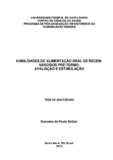| dc.creator | Bolzan, Geovana de Paula | |
| dc.date.accessioned | 2019-07-26T20:52:06Z | |
| dc.date.available | 2019-07-26T20:52:06Z | |
| dc.date.issued | 2015-02-27 | |
| dc.identifier.uri | http://repositorio.ufsm.br/handle/1/17572 | |
| dc.description.abstract | This research aimed to assess the accuracy of the Preterm Oral Feeding Readiness Scale (POFRAS) on the beginning of oral feeding in preterm infants and to verify the accordance of the results of this instrument with those from the oral feeding skill level evaluation. Also, to compare the effectiveness of sensorimotor oral stimulation (SMOS) programs and of a vibratory stimulus combined with SMOS program on feeding transition and length of hospital stay of preterm infants. The study was conducted in three stages. In the first, 82 preterm infants were assessed by POFRAS regarding their readiness to initiate oral feeding and by oral feeding skill level evaluation according to their feeding performance during the first oral feeding. In the second stage, 55 preterm infants with low oral ability were allocated into two groups that received SMOS through Nonnutritive Oral Motor Therapy (NNOMT) and Premature Infant Oral Motor Intervention (PIOMI) programs. Finally, in the third stage, 43 preterm infants were randomly assigned into two groups, who received SMOS through PIOMI, with and without the association of a vibratory stimulus. It was found that POFRAS's accuracy to start oral feeding was average and the results of this instrument showed weak agreement with those obtained in the oral feeding skill level evaluation. There was no difference between the SMOS programs tested on the feeding transition. However, the vibratory stimulus combined with SMOS program seems to contribute to reduce the length of hospital stay of preterm newborns. | eng |
| dc.description.sponsorship | Coordenação de Aperfeiçoamento de Pessoal de Nível Superior - CAPES | por |
| dc.language | por | por |
| dc.publisher | Universidade Federal de Santa Maria | por |
| dc.rights | Attribution-NonCommercial-NoDerivatives 4.0 International | * |
| dc.rights.uri | http://creativecommons.org/licenses/by-nc-nd/4.0/ | * |
| dc.subject | Recém-nascido | por |
| dc.subject | Prematuro | por |
| dc.subject | Comportamento alimentar | por |
| dc.subject | Sucção | por |
| dc.subject | Avaliação | por |
| dc.subject | Terapêutica | por |
| dc.subject | Vibração | por |
| dc.subject | Newborn | eng |
| dc.subject | Premature | eng |
| dc.subject | Feeding behavior | eng |
| dc.subject | Suction | eng |
| dc.subject | Evaluation | eng |
| dc.subject | Therapeutics | eng |
| dc.subject | Vibration | eng |
| dc.title | Habilidades de alimentação oral de recém-nascidos pré-termo: avaliação e estimulação | por |
| dc.title.alternative | Oral feeding skills in newborn preterm: evaluation and stimulation | eng |
| dc.type | Tese | por |
| dc.description.resumo | Esta pesquisa teve por objetivos avaliar a acurácia do Preterm Oral Feeding Readiness Scale - POFRAS para início da alimentação oral de recém-nascidos pré-termo (RNPT) e sua concordância com a avaliação quantitativa do Nível de Habilidade Oral; comparar a eficácia de programas de estimulação sensório-motora oral (ESMO) e da associação de estímulo vibratório à ESMO, sobre a transição alimentar e o tempo de internação de RNPT. O estudo foi realizado em três etapas. Da primeira, participaram 82 RNPT, avaliados quanto à prontidão para início da alimentação oral por meio do POFRAS e quanto à performance alimentar por meio da avaliação do Nível de Habilidade Oral, durante a primeira alimentação oral. Da segunda etapa, participaram 55 RNPT, com baixa habilidade oral, alocados em dois grupos que receberam ESMO por meio dos programas Nonnutritive Oral Motor Therapy (NNOMT) e Premature infant oral motor intervention (PIOMI). Da terceira etapa, participaram 43 RNPT randomizados em dois grupos, que realizaram ESMO por meio do PIOMI, com e sem a associação de um estímulo vibratório. Verificou-se que a acurácia do POFRAS para o início da alimentação oral foi regular e que os resultados deste instrumento apresentam fraca concordância com os obtidos na avaliação do Nível de Habilidade Oral. Não houve diferença entre os programas de ESMO testados quanto ao tempo para obtenção da via oral plena, no entanto o estímulo vibratório associado à ESMO parece contribuir para a redução dos dias de internação hospitalar de RNPT. | por |
| dc.contributor.advisor1 | Weinmann, Angela Regina Maciel | |
| dc.contributor.advisor1Lattes | http://lattes.cnpq.br/9151119377173425 | por |
| dc.contributor.advisor-co1 | Silva, Ana Maria Toniolo da | |
| dc.contributor.advisor-co1Lattes | http://lattes.cnpq.br/3609781201156265 | por |
| dc.contributor.referee1 | Guedes, Zelita Caldeira Ferreira | |
| dc.contributor.referee1Lattes | http://lattes.cnpq.br/0030052121324047 | por |
| dc.contributor.referee2 | Levy, Deborah Salle | |
| dc.contributor.referee2Lattes | http://lattes.cnpq.br/0452780908837821 | por |
| dc.contributor.referee3 | Keske-Soares, Marcia | |
| dc.contributor.referee3Lattes | http://lattes.cnpq.br/2993790524055307 | por |
| dc.contributor.referee4 | Haeffner, Leris Salete Bonfanti | |
| dc.contributor.referee4Lattes | http://lattes.cnpq.br/4056008693346464 | por |
| dc.creator.Lattes | http://lattes.cnpq.br/6911505466941984 | por |
| dc.publisher.country | Brasil | por |
| dc.publisher.department | Fonoaudiologia | por |
| dc.publisher.initials | UFSM | por |
| dc.publisher.program | Programa de Pós-Graduação em Distúrbios da Comunicação Humana | por |
| dc.subject.cnpq | CNPQ::CIENCIAS DA SAUDE::FONOAUDIOLOGIA | por |
| dc.publisher.unidade | Centro de Ciências da Saúde | por |



